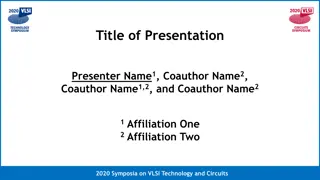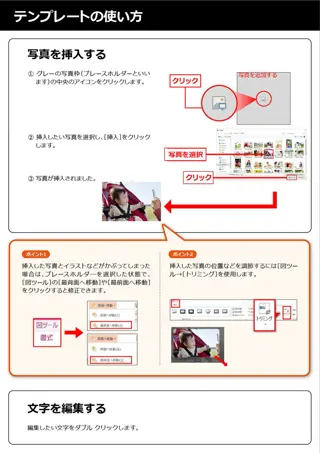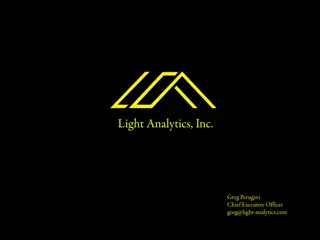
Understanding Price Elasticity for Business Growth
Learn the concept of elasticity and its application in pricing strategies. Explore the price elasticity of demand and how it impacts sales and revenue for local businesses in this informative presentation.
Uploaded on | 1 Views
Download Presentation

Please find below an Image/Link to download the presentation.
The content on the website is provided AS IS for your information and personal use only. It may not be sold, licensed, or shared on other websites without obtaining consent from the author. If you encounter any issues during the download, it is possible that the publisher has removed the file from their server.
You are allowed to download the files provided on this website for personal or commercial use, subject to the condition that they are used lawfully. All files are the property of their respective owners.
The content on the website is provided AS IS for your information and personal use only. It may not be sold, licensed, or shared on other websites without obtaining consent from the author.
E N D
Presentation Transcript
ELASTICITY AND ITS APPLICATION Design and deliver beautiful presentations with ease and confidence.
Elasticity Basic idea: Elasticity measures how much one variable responds to changes in another variable. One type of elasticity measures how much demand for your websites will fall if you raise your price. Definition: Elasticity is a numerical measure of the responsiveness of Qd or Qs to one of its determinants. 2
Price Elasticity of Demand Percentage change in Qd Price elasticity of demand = Percentage change in P Price elasticity of demand measures how much Qd responds to a change in P. Loosely speaking, it measures the price- sensitivity of buyers demand. 3
Price Elasticity of Demand Percentage change in Qd Price elasticity of demand = Percentage change in P P Example: P rises by 10% Price elasticity of demand equals P2 P1 D 15% 10% Q = 1.5 Q2 Q1 Q falls by 15% 4
Price Elasticity of Demand Percentage change in Qd Price elasticity of demand = Percentage change in P P Along a D curve, P and Q move in opposite directions, which would make price elasticity negative. We will drop the minus sign and report all price elasticities as positive numbers. P2 P1 D Q Q2 Q1 5
A scenario You design websites for local businesses. You charge $200 per website, and currently sell 12 websites per month. Your costs are rising (including the opportunity cost of your time), so you consider raising the price to $250. The law of demand says that you won t sell as many websites if you raise your price. How many fewer websites? How much will your revenue fall, or might it increase? 6
Calculating Percentage Changes Standard method of computing the percentage (%) change: Demand for your websites end value start value start value P x 100% B $250 Going from A to B, the % change in P equals A $200 D ($250 $200)/$200 = 25% Q 8 12 7
Calculating Percentage Changes Problem: The standard method gives different answers depending on where you start. Demand for your websites P From A to B, P rises 25%, Q falls 33%, elasticity = 33/25 = 1.33 B $250 A $200 From B to A, P falls 20%, Q rises 50%, elasticity = 50/20 = 2.50 D Q 8 12 8
Calculating Percentage Changes So, we instead use the midpoint method: end value start value midpoint x 100% The midpoint is the number halfway between the start & end values, the average of those values. It doesn t matter which value you use as the start and which as the end you get the same answer either way! 9
Calculating Percentage Changes Using the midpoint method, the % change in P equals $250 $200 $225 x 100% = 22.2% The % change in Q equals 12 8 10 The price elasticity of demand equals x 100% = 40.0% 40/22.2 = 1.8 10
What determines price elasticity? 1. Price elasticity is higher when close substitutes are available 2. Price elasticity is higher for narrowly defined goods than broadly defined ones. 3. Price elasticity is higher for luxuries than for necessities 4. Price elasticity is higher in the long run than the short run. 11
The Variety of Demand Curves The price elasticity of demand is closely related to the slope of the demand curve. Rule of thumb: The flatter the curve, the bigger the elasticity. The steeper the curve, the smaller the elasticity. Five different classifications of Dcurves. 12
Perfectly inelastic demand (one extreme case) % change in Q % change in P 0% 10% Price elasticity of demand = 0 = = P D curve: vertical D P1 Consumers price sensitivity: none P2 P falls by 10% Q Elasticity: 0 Q1 Q changes by 0% 13
Inelastic demand < 10% 10% % change in Q % change in P Price elasticity of demand < 1 = = P D curve: relatively steep P1 Consumers price sensitivity: relatively low P2 D P falls by 10% Q Elasticity: < 1 Q1 Q2 Q rises less than 10% 14
Unit elastic demand 10% 10% % change in Q % change in P Price elasticity of demand = 1 = = P D curve: intermediate slope P1 Consumers price sensitivity: intermediate P2 D P falls by 10% Q Elasticity: 1 Q1 Q2 Q rises by 10% 15
Elastic demand > 10% 10% % change in Q % change in P Price elasticity of demand > 1 = = P D curve: relatively flat P1 Consumers price sensitivity: relatively high P2 D P falls by 10% Q Elasticity: > 1 Q1 Q2 Q rises more than 10% 16
Perfectly elastic demand (the other extreme) % change in Q % change in P any % 0% Price elasticity of demand = infinity = = P D curve: horizontal D P1 P2 = Consumers price sensitivity: extreme P changes by 0% Q Elasticity: infinity Q2 Q1 Q changes by any % 17
Elasticity of a Linear Demand Curve The slope of a linear demand curve is constant, but its elasticity is not. P 200% 40% $30 E = = 5.0 67% 67% 20 E = = 1.0 40% 200%= 0.2 10 E = $00 Q 20 40 60 18






















